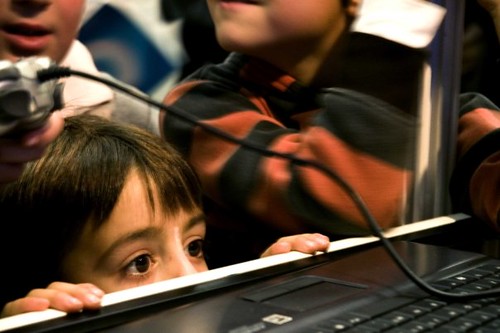Raising "Mini-Me"
 Raising children can be the most rewarding, but most challenging responsibility a parent will ever have. Not too long ago, we looked at raising children who have very different personalities than ourselves. Today we will explore raising a child who has that likes the same things and shares many of the same talents. Having a child who mirrors you may seem easier than one who's different, but that's not always the case. According to the June/July issue of Working Mothers, below are some of the common pitfalls and how to avoid them.
Raising children can be the most rewarding, but most challenging responsibility a parent will ever have. Not too long ago, we looked at raising children who have very different personalities than ourselves. Today we will explore raising a child who has that likes the same things and shares many of the same talents. Having a child who mirrors you may seem easier than one who's different, but that's not always the case. According to the June/July issue of Working Mothers, below are some of the common pitfalls and how to avoid them.1. You assume you know what your child wants. You think, I bet he'd like this shirt; I'll buy it. Or, He'll/She'll want to take this class for sure, so I'll sign him/her up. "Taking for granted that you know what your child want without asking can make him/her feel like they have not say in what they do,: says Tanya Altmann, MD, a clinical professor of pediatrics at UCLA. Share things you both enjoy by watching football, going to museums, playing tennis, whatever. Just ask first.
2. You dream for your child. Your child is a computer whiz, just like you, so you're already imagining their career. Reality check: Don't assume your know what your child wants to be when they grow up. They may turn out to be a composer, not a computer programmer or discover a passion you've never imagined. "Kids need the space to explore what they like," says parenting educator Betsy Brown Braun. "Part of a child's job is to grow, separate and make their own way in the world."
3. You fight a lot. "Often the child who's most like you is the one you spar with," says Brown Braun. "When you argue with a child who's like you, you may be fighting against things you don't like in yourself. Recognize and acknowledge that, then use your experience to help your child. If they see him/her struggling with something you also struggle with, say something like "You and I are a lot alike. This was always hard for me, but this strategy helped me. Maybe it will help you, too."








 According to August 30, 2010, Forbes magazine, the best colleges in America isn't in Cambridge or Princeton, West Point or Annapolis. William College, a 217-year old private liberal arts school, tops the third annal ranking of America's Best Colleges, compiled with research by the Center of College Affordability & Productivity. Williams rose to the top spot on the rankings after placing fourth last year and fifth in 2008.
According to August 30, 2010, Forbes magazine, the best colleges in America isn't in Cambridge or Princeton, West Point or Annapolis. William College, a 217-year old private liberal arts school, tops the third annal ranking of America's Best Colleges, compiled with research by the Center of College Affordability & Productivity. Williams rose to the top spot on the rankings after placing fourth last year and fifth in 2008. According to an article in Parenting.com May 2010, below you will find 6 ways to sneak in exercise with your kids and have fun at the same time.
According to an article in Parenting.com May 2010, below you will find 6 ways to sneak in exercise with your kids and have fun at the same time.
 Curiosity is the key to student success now and in the future. Kids are naturally curious. Set them loose in a room full of craft supplies or a muddy sandbox, and you'll see their imaginations come to life. The following ideas are how to nurture curiosity for the beginning according to Todd Kashdan, author of Curious? Discover the Missing Ingredient to a Fulfilling Life and clinical psychologist and professor psychology at George Mason University. The following are 6 ideas on how to nurture curiosity in the classroom according to an article in Instructor magazine 1020: Although this article was intended for educators, parents can take the same information for nurturing their own children.
Curiosity is the key to student success now and in the future. Kids are naturally curious. Set them loose in a room full of craft supplies or a muddy sandbox, and you'll see their imaginations come to life. The following ideas are how to nurture curiosity for the beginning according to Todd Kashdan, author of Curious? Discover the Missing Ingredient to a Fulfilling Life and clinical psychologist and professor psychology at George Mason University. The following are 6 ideas on how to nurture curiosity in the classroom according to an article in Instructor magazine 1020: Although this article was intended for educators, parents can take the same information for nurturing their own children.


 Today, we will be looking at the last "Parenting by Personality", the Artsy Kid vs. All-Thumbs Mom. Your child is artistic; you're not. You don't have to be a good at art to appreciate it, especially your child's creations. "Your young Rembrandt's work can give you insight into his/her mind, "says Dr. Berman, PsyD, a Los Angeles-based family therapist and author of The A to Z Guide to Raising Happy, Confident Kids. "That's why therapist employ art therapy. Creating something with your child is a wonderful opportunity to have fun together and for both of you to let down your inhibitions and get your fingers dirty."
Today, we will be looking at the last "Parenting by Personality", the Artsy Kid vs. All-Thumbs Mom. Your child is artistic; you're not. You don't have to be a good at art to appreciate it, especially your child's creations. "Your young Rembrandt's work can give you insight into his/her mind, "says Dr. Berman, PsyD, a Los Angeles-based family therapist and author of The A to Z Guide to Raising Happy, Confident Kids. "That's why therapist employ art therapy. Creating something with your child is a wonderful opportunity to have fun together and for both of you to let down your inhibitions and get your fingers dirty."
 If you and your different-from-you child have problems communicating or connecting, it is up to you to figure out the best way to reconnect. Today we will be looking at The Innie vs. the Outie. Your child is an introvert and you're an extrovert. According to an article in the June/July issue of Working Mother magazine, what you need to know is that although your child's shyness may worry you because you love to socialize, it's only a problem it it's a problem for the child. Spending time alone may mean the child enjoys their own company, a sign of good self-esteem. Talk to your child's teacher to determine how he/she interacts socially at school; could be they are just cautious and takes time to make friends, which is a trait you may want to encourage.
If you and your different-from-you child have problems communicating or connecting, it is up to you to figure out the best way to reconnect. Today we will be looking at The Innie vs. the Outie. Your child is an introvert and you're an extrovert. According to an article in the June/July issue of Working Mother magazine, what you need to know is that although your child's shyness may worry you because you love to socialize, it's only a problem it it's a problem for the child. Spending time alone may mean the child enjoys their own company, a sign of good self-esteem. Talk to your child's teacher to determine how he/she interacts socially at school; could be they are just cautious and takes time to make friends, which is a trait you may want to encourage. Parenting is a hard job, but when you and your child have opposing personalities, life can become really difficult if you don't try to understand exactly what is going on. What happens when your child is athletic and you're not? This is another example of conflicting personalities between parent and child. The Jock vs. the Couch Potato. "What you need to know is that it doesn't matter if you like sports or not," says Dr. Berman. " What matters is you love your child and want to learn about his/her world. Letting kids teach us about the things they love helps us connect with them and understand their life."
Parenting is a hard job, but when you and your child have opposing personalities, life can become really difficult if you don't try to understand exactly what is going on. What happens when your child is athletic and you're not? This is another example of conflicting personalities between parent and child. The Jock vs. the Couch Potato. "What you need to know is that it doesn't matter if you like sports or not," says Dr. Berman. " What matters is you love your child and want to learn about his/her world. Letting kids teach us about the things they love helps us connect with them and understand their life." Opposing parent-child personalities that clash can be very challenging. According to an article in the June/July issue of Working Mother magazine, raising a child who's nothing like you can make you feel like you brought the wrong child home from the hospital. Today we will be looking at The Mess vs. Ms. Meticulous. In other words, your child is a slob and you're neat.
Opposing parent-child personalities that clash can be very challenging. According to an article in the June/July issue of Working Mother magazine, raising a child who's nothing like you can make you feel like you brought the wrong child home from the hospital. Today we will be looking at The Mess vs. Ms. Meticulous. In other words, your child is a slob and you're neat.



 You've put off having "the talk" with your middle schooler, thinking there's no rush. Or is there? "One in five kids has sex by the time they're 15," says Laura Berman, Ph.D., author of Talking to Your Kids About Sex. And 40% have intercourse before discussing safe practices or abstinence with their parents, according to a survey results published in Pediatrics. Frank talk with your kid about sex may make you uncomfortable, even scared, but it's not as scary as having a kid who is pregnant or has an STD.
You've put off having "the talk" with your middle schooler, thinking there's no rush. Or is there? "One in five kids has sex by the time they're 15," says Laura Berman, Ph.D., author of Talking to Your Kids About Sex. And 40% have intercourse before discussing safe practices or abstinence with their parents, according to a survey results published in Pediatrics. Frank talk with your kid about sex may make you uncomfortable, even scared, but it's not as scary as having a kid who is pregnant or has an STD.
 According to Tiffany Forte, if you have a 1-year old, he/she may be happy rocking out on their piano when your preschool-age brother calls for you. All too soon, the baby's happy tunes turn to whines, then to wails, as he/she sees you dote on the other sibling. They are fed, dry, and was happy moments ago. So what is this?
According to Tiffany Forte, if you have a 1-year old, he/she may be happy rocking out on their piano when your preschool-age brother calls for you. All too soon, the baby's happy tunes turn to whines, then to wails, as he/she sees you dote on the other sibling. They are fed, dry, and was happy moments ago. So what is this? Gone are the days when you kid wakes up before the crack of dawn from ages 10-12. Now it takes all your morning energy just to get him/her out of bed. What's going on? The sleep patterns of preteens are different from those of adults and young children.. Their bodies' internal clocks actually tell them to fall asleep later at night and to snooze longer in the morning. (So why the heck does their school usually start earlier than your kindergartner's? Go figure!) According to Deb Lehman, in the May 2010 issue of Parenting.com magazine, below are some suggestions on how to make the morning wake-ups less of a struggle:
Gone are the days when you kid wakes up before the crack of dawn from ages 10-12. Now it takes all your morning energy just to get him/her out of bed. What's going on? The sleep patterns of preteens are different from those of adults and young children.. Their bodies' internal clocks actually tell them to fall asleep later at night and to snooze longer in the morning. (So why the heck does their school usually start earlier than your kindergartner's? Go figure!) According to Deb Lehman, in the May 2010 issue of Parenting.com magazine, below are some suggestions on how to make the morning wake-ups less of a struggle:




 With all the news about the rise in autism, you may have also heard about Asperger's Syndrome. It's a sub-type of autism spectrum disorder first identified 65 years ago. As with autism, the cause of Asperger's is unknown, and it occurs more frequently in boys that in girls. In an article from the October, 2009 issue of Scholastic Parent and Child, Lynn Kern Koegel, Ph.D., the clinical director of the Koegel Autism Center and director of Eli and Edythe L. Board Center for Asperger Research at the University of California, Santa Barbara, to explain what Asperger's Syndrome is and how professionals are treating it.
With all the news about the rise in autism, you may have also heard about Asperger's Syndrome. It's a sub-type of autism spectrum disorder first identified 65 years ago. As with autism, the cause of Asperger's is unknown, and it occurs more frequently in boys that in girls. In an article from the October, 2009 issue of Scholastic Parent and Child, Lynn Kern Koegel, Ph.D., the clinical director of the Koegel Autism Center and director of Eli and Edythe L. Board Center for Asperger Research at the University of California, Santa Barbara, to explain what Asperger's Syndrome is and how professionals are treating it.

